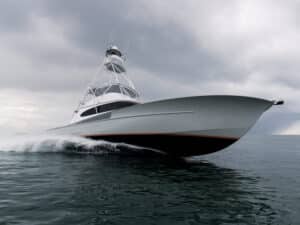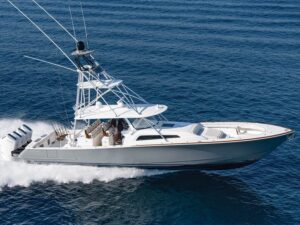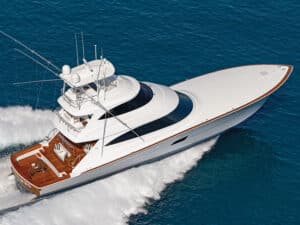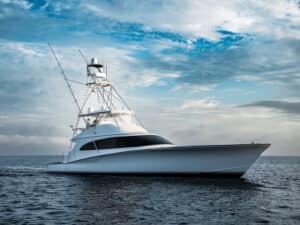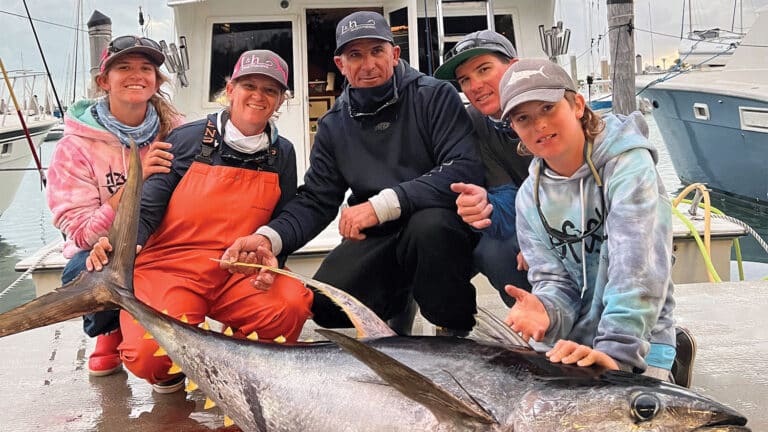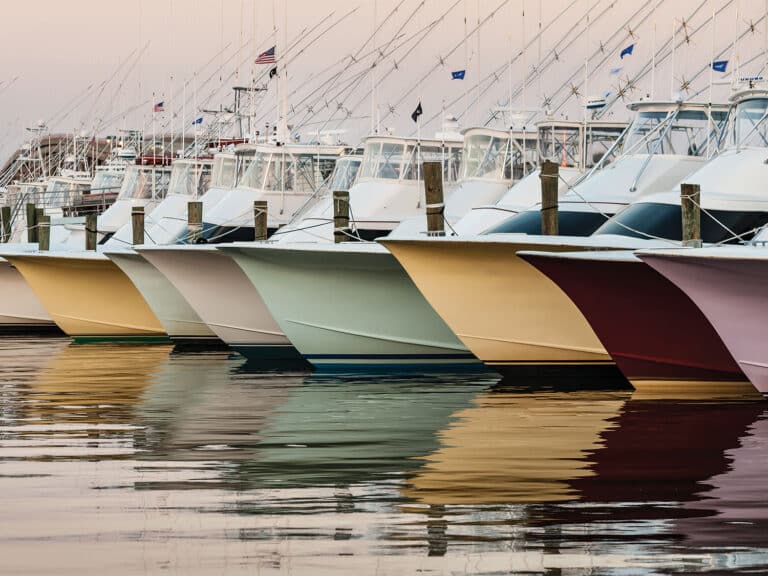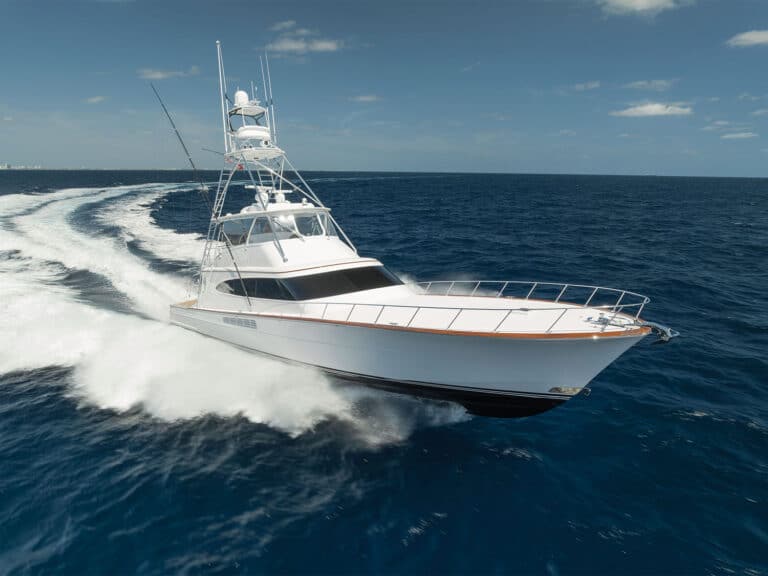At times, the cynic in me takes over. That’s often the case when I see yet another new custom-fishing boat builder come on the scene, scratching to build another ”me-too” boat. Thankfully, once in a while a new boat comes along with enough unique thought put into its design and creation that my cynicism gets jostled from its sedentary perch. The Weaver 65 is just such a boat.
P e r f o r m a n c e
“Giddyap” will never be a problem for the Weaver 65. Naval architect Donald Blount — considered by many to be the top high-speed planing-hull designer in the world today — drew the lines for the Weaver 65, and after running her outside of Lake Worth Inlet in Palm Beach, I can guarantee you his reputation stands. On plane in 12 seconds, Dream Weaver stayed dry on every point of sea and never wavered on its course. Top speed averaged just over 40 knots at 2,350 rpm, while the most efficient and comfortable cruising speed hit 32.5 knots at 1,850 rpm. Turns at speed were accomplished predictably with a moderate lean into the turn; a 180-degree arc required approximately five boat lengths. Trim-tab adjustment proved adequate, though I would like response to be slightly quicker.
F i s h a b i l i t y
The mezzanine at the forward end of the Weaver’s cockpit allows guests to watch the fishing action without actually getting in the way, and it adds considerably more storage space. You even get two air-conditioning ducts in the overhang to take the brutality out of those still, scorching summer trolls. Weaver supplies all the regular fishing amenities, plus a 600-pound-per-day Eskimo ice machine, kick-ass Bose stereo system, stainless-steel refrigerated drink box and a gunwale that hits you at just the right height for keeping you well balanced inboard but still able to revive a fish when necessary.
F l y b r i d g e
Dream Weaver’s large flybridge sports some innovative features. If cleanliness is truly next to godliness, then Dream Weaver must cruise the heavens. All the radios, sea-temp gauge, GPS and other electronics flush-mount into a panel that drops down from the overhead. Also hidden overhead — two Miya Epoch electric teaser reels. Larger electronic instrumentation such as chart plotters, radar, engine displays and the like flush-mount behind clear laminated glass, with teak trim on the helm console. Weaver answered two of my pet peeves with flybridge designs. It provides plenty of room to access the guest helm seat, while still offering a superb view of the cockpit from the helm — a tough combination. Another great feature is the access to the bridge: The ladder faces outboard and bends at a comfortable angle for climbing up and down. But when going up, you aren’t faced with the sense you’re about to fall overboard through the space between the tower leg and the coaming. A welded bar keeps you inboard while providing another great handhold. Of course, you get the obligatory seating for guests, with storage beneath. But you also get one aft-facing seat to starboard with a comfortable, removable seat back to make watching the lure spread more pleasurable.
E n g i n e R o o m
Like many other places aboard Dream Weaver, the engine-room design makes boating easier. For example, open the cockpit hatch to the engine room and you find remote light, blower and generator switches immediately at hand. As you step down the ladder, you also see — directly in front of you — a half-dozen finished storage tubes to accommodate mops, gaffs, tag sticks and so on. Testing has shown that above certain speeds (slightly different for each boat, but generally around 32 to 35 knots), a barrier layer of dead air surrounds the hull. If you’re depending on standard air intakes cut into the topsides for your engines’ needs, you’re likely to be disappointed, as the engines probably won’t get enough air to perform properly. That’s why so many faster sport-fishing boats, including the Dream Weaver, have Delta T blower systems in their engine compartments. These individually designed systems actually pressurize the engine room, assuring more than enough air for optimal combustion. Weaver’s engine rooms get fully faired and coated with Awl grip before the engines ever get mounted, so keeping the compartment clean can be a breeze if you keep up with it. About my only complaint here rests with the location of the pump room — adjacent to the living quarters. I prefer to have it aft.
I n t e r i o r
Perhaps nowhere aboard does Weaver throw the ”business-as-usual” book out the window as in the interior. Right off the bat you can’t help but notice the interior wood — all rare Obechi — that gleams with 14 coats of polyester varnish. The triangular Scopinich table in the salon raises and lowers as needed without being bothersome underway. A unique island on centerline acts as breakfast counter and food-prep area. The opposing L-shaped counters work well, effectively making this galley as big as the kitchen in most homes. And the SubZero undercounted refrigerator and freezer keep the entire salon free of visual obstructions. Weaver continues to innovate below decks, running the companionway along the port side, using rather than ignoring the beautiful curve of the hull. The outboard side boasts an art gallery and copious storage for rods and other sundries in full-length cabinets. The starboard master cabin places a true queen berth against the forward bulkhead. Thank you! I hate sleeping with my head lower than my feet. The queen berth lifts on rams at the touch of a button to reveal yet more storage. And finally, the master has a private head with separate shower stall. Forward, a guest stateroom provides a double berth on one side and a single upper berth along the companionway wall. It, too, boasts its own head and shower. Finally, a third stateroom sits aft, abutting the engine room bulkhead with two athwart ship, over/under singles, concealed washer/dryer stack and more storage. Directly across from the guest cabin, at the foot of the salon stairs, lies a day head. I found the Weaver 65 to be quiet, dry, responsive and as close to art as boatbuilding can get. The cold-molded hull, combined with a 121/2-degree dead rise at the transom and a sharp, 23.7-degree dead rise at the boat’s center of gravity, makes for a cushioned ride that the most demanding skippers will appreciate. Jim Weaver is no ”me-too” builder.
